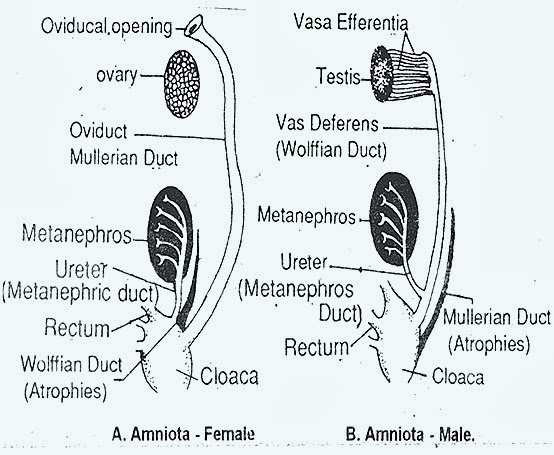EXCRETORY SYSTEM OF REPTILE-BIRD-MAMMAL-COMPARISON
EXCRETORY SYSTEM OF LIZARD AND COMPARE WITH THAT PIGEON AND RABBIT.
Lizard,bird and rabbit all these three animals come under the group amniota. The taking away of nitrogenous un wanted waste products from the body is called excretion. If excretion takes place not properly in the body they become poisonous. vertebrates main excretory organs are called as kidneys. skin-gills-lungs-liver-intestine are also acts as accessory excretory organs.
The kidneys are made up with numerous uriniferous tubules.kidneys are located in dorsal side of coelom.
A typical uriniferous tubule having three parts-
1-ciliated peritoneal funnel
2-malpighian body
3-ciliated convoluted tube.

| EXCRETORY SYSTEM -GARDEN LIZARD | EXCRETORY SYSTEM -PIGEON | EXCRETORY SYSTEM-RABBIT |
| 1. Paired kidneys are dark red and irregular in shape. These are flattened organs. | 1. Kidneys are dark red and some what rectangular and flattened organs. | 1. Kidneys are dark red and bean shaped organs. |
| 2. Kidneys are located in the posterior region of the abdominal cavity and attached to the dorsal wall by a fold of peritoneum. | 2. Kidneys are situated in the anterior part of the abdomen. | 2. Kidneys are located in the posterior part of the abdominal cavity. |
| 3. Right and left kidneys are opposite to each other. | 3. Same as in calotes | 3. The two kidneys are distinct. The right kidney lies much ahead than the left kidney. |
| 4. They are attached to the dorsal muscles. | 4. They are fitted in the hollows of the pelvic girdle. | 4. Same as in calotes. |
| 5. They are very near to the median line kidneys are Metanephros type. | 5. They are a little away from the median line. Kidneys are Meta nephros type. | 5. They are well away from the median line. Kidneys are meta ne phros type. |
| 6. Each kidney has two lobes Anterior lobe is broad and posterior lobe is broad Hilus is absent. | 5. Each kidney has three lobes They are anterior, median and posterior lobes. Hilus is absent. | 6. Each kidney is a sin-gle-lobed structure. Inner side of the kidney has a concave depression is known as the 'hilus'. |
| 7. The two kidneys are united posteriorly forming a V - shaped structure. | 7. The two kidneys are separate and do not fuse with each other. | 7. The two kidneys are distinct. |
| 8. The two ureters are narrow, thin-walled ducts extending behind from the kidneys to the cloaca, where these open into the urodaeum. | 8. Same as in Calotes. | 8. The ureters open into the urinary bladder. Ureters arise from the hilus of each kidney. |
| 9. There is no pelvis. | 9. There is no pelvis. | 9. Each ureter is expanded in its kidney into a funnel like pelvis. |
| 10. In males the ureters join at its posterior end with its corresponding vas deferens and both open by a common urino-genital aperture. | 10 The ureters do not join with the vas deferens and both open separately into the cloaca. | 10. Ureters open separately into the urinary bladder. |
| 11. A thin walled urinary bladder opens on the ventral side of cloaca | 11. Urinary bladder is absent | 11. Urinary bladder is a large, median, pear, shaped, thin walled transparent sac. |
| 12. Urinary bladder communicates with urodaeum thrumph its ventral wall. | 12. _ | 12.Urinary bladder opens into the urethra or unnogenital canal. |
| 13. Calotes is uricotelic animal Urine consists n.ainly of uric acid. | 13. Urine consists mainly of uric acid cotelic animal | 13. Urine consists mainly of urea- ureotelic animal |
| 14. Urine is excreted in a semi solid state. | 14. Urine is excreted ir a semisolid state (Bird droppinos). | 14. Urine is passed out in a fluid state. |
